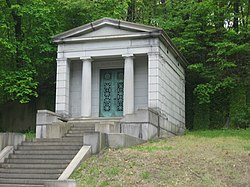For the cemetery in New Jersey, see Glendale Cemetery, Bloomfield.
| This article needs additional citations for verification. Please help improve this article by adding citations to reliable sources. Unsourced material may be challenged and removed. Find sources: "Glendale Cemetery" – news · newspapers · books · scholar · JSTOR (March 2021) (Learn how and when to remove this message) |
| Glendale Cemetery | |
| U.S. National Register of Historic Places | |
| U.S. Historic district | |
 A mausoleum on the main drive A mausoleum on the main drive | |
  | |
| Location | 150 Glendale Avenue Akron, Ohio |
|---|---|
| Coordinates | 41°05′05″N 81°31′41″W / 41.0847700°N 81.5281686°W / 41.0847700; -81.5281686 |
| Area | 88 acres (36 ha) |
| Built | 1839 |
| Architect | Albert Sargent; et al. |
| Architectural style | Rural cemetery |
| NRHP reference No. | 01001063 |
| Added to NRHP | September 28, 2001 |
Glendale Cemetery is a historic rural cemetery located in Akron, Ohio. It was added to the National Register of Historic Places in 2001.
History
Glendale Cemetery was founded in 1839 by Dr. J.D. Commons. Here statues of prominent citizens, an avenue of stately mausoleums and a collection of headstones tell the story of Akron's past. Originally known as Akron Rural Cemetery, Commons modeled the design of the cemetery after Boston's Mount Auburn Cemetery, which he visited in 1838. Glendale is a picturesque romantic landscape with its curving roads, use of promontories to create vistas and a variety of architectural styles that draw upon ancient building forms. Mausoleums are modeled after Egyptian, Greek and Roman temples or Gothic churches. Nineteenth-century accounts described Glendale as “beautifully laid out in romantic drives and walks” and note its role as an area park and tourist destination.
Originally, the cemetery had a stream and two bodies of water—Willow and Swan Lakes. Due to the increased development surrounding the cemetery during the late 19th century, the natural spring that fed the lakes dried up. The superintendent of the cemetery at that time proposed running a pipe to the Ohio and Erie Canal to re-water the lakes, but this was never realized. Today the open space or Great Meadow recalls the scale of Swan Lake and several mausoleums have small foot bridges that once crossed over the stream fronting them. Distinct sections of the cemetery are devoted to the Masons, Akron's Jewish community and infants and children. The Civil War is prominently commemorated in Glendale Cemetery. The Buckley Post of the Union Army has a large memorial marker surrounded by 50 headstones located on the northern plateau. The 1876 Gothic Revival style Memorial Chapel was constructed by the Buckley Post and has been recently restored.
Akron Rural Cemetery Buildings
United States historic place| Akron Rural Cemetery Buildings | |
| U.S. National Register of Historic Places | |
 Postcard showing buildings near the entrance Postcard showing buildings near the entrance | |
| Location | Akron, Ohio |
|---|---|
| Architect | Frank O. Weary |
| Architectural style | Gothic |
| NRHP reference No. | 80003236 |
| Added to NRHP | 1980-09-27 |
The cemetery holds the Akron Rural Cemetery Buildings, a registered historic site, listed in the National Register on 1980-09-27. They are credited to prominent Akron architect Frank O. Weary. The four buildings are:
- The Memorial Chapel, built in 1876 as an American Civil War monument and was erected by Buckley Post #12 Grand Army of the Republic.
- The Bell Tower, built in 1883
- The Caretakers Lodge, built in 1869
- The Office, built in 1903
Notable interments
- Ohio Columbus Barber (1841–1920), industrialist and philanthropist; founder of the Barber Match Company and Barberton, Ohio
- Ellsworth Bathrick (1863–1917), US Congressman
- John Buchtel (1820–1892), businessman and founder of Buchtel College, the predecessor of the University of Akron
- George Washington Crouse (1832–1912), US Congressman
- Charles W.F. Dick (1858–1945), US Senator
- Charles S. Howe (1858–1939), 2nd President of Case School of Applied Science (present-day Case Western Reserve University)
- Lewis Miller.(1829–1899), philanthropist and inventor
- Julia Perry (1927–1979), composer, conductor, and educator
- George Edmond Pierce (1794–1871), 2nd President of Western Reserve College (present-day Case Western Reserve University)
- Frank Seiberling (1859–1955), early 20th century industrialist; founder of the Goodyear Tire and Rubber Company and the Seiberling Rubber Company.
- John F. Seiberling (1918–2008), US Congressman and grandson of Goodyear founder F.A. Seiberling
- William Hanford Upson (1823–1910), 19th century politician, lawyer, and judge
References
- ^ "National Register Information System". National Register of Historic Places. National Park Service. March 13, 2009.
- ^
 This article incorporates public domain material from Glendale Cemetery. National Park Service.
This article incorporates public domain material from Glendale Cemetery. National Park Service.
External links
![]() Media related to Glendale Cemetery, Akron, Ohio at Wikimedia Commons
Media related to Glendale Cemetery, Akron, Ohio at Wikimedia Commons
- Glendale Cemetery at Find a Grave

- National Register nomination form
- U.S. Geological Survey Geographic Names Information System: Glendale Cemetery
- 1839 establishments in Ohio
- Buildings and structures in Akron, Ohio
- Cemeteries on the National Register of Historic Places in Ohio
- Tourist attractions in Akron, Ohio
- Protected areas of Summit County, Ohio
- National Register of Historic Places in Summit County, Ohio
- Historic districts on the National Register of Historic Places in Ohio
- Cemeteries in Summit County, Ohio
- Rural cemeteries
- Cemeteries established in the 1830s

